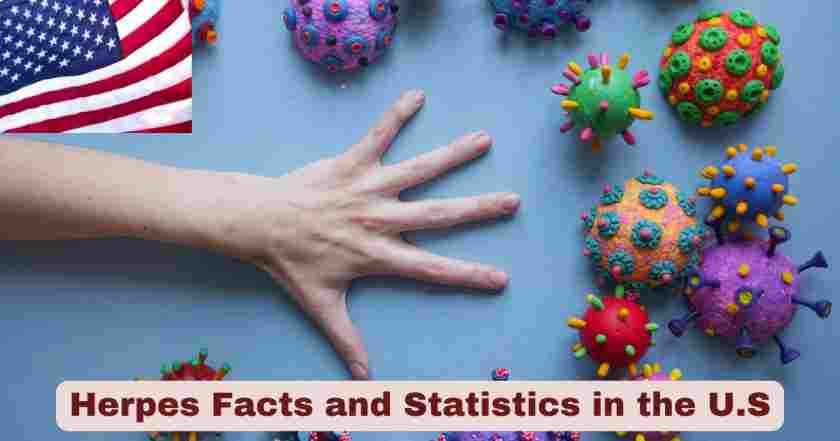Herpes in the U.S in 2025
The landscape of herpes infections in the United States continues to present significant public health challenges as we move through 2025. Genital herpes remains a common sexually transmitted infection (STI) that affects sexually active individuals across all demographics, with millions of Americans living with both oral and genital forms of the virus. The Centers for Disease Control and Prevention maintains that understanding the scope and impact of herpes infections is crucial for developing effective prevention strategies and ensuring appropriate medical care for those affected.
Current surveillance data reveals that herpes simplex virus continues to affect a substantial portion of the U.S. population, with both HSV-1 and HSV-2 maintaining significant prevalence rates. In 2018, CDC estimates show there were 572,000 new genital herpes infections in the U.S. among people aged 14 to 49, highlighting the ongoing transmission patterns that persist into the current decade. The medical community recognizes that these infections often go undiagnosed due to their frequently asymptomatic nature, making comprehensive education and testing initiatives more important than ever. For individuals seeking discreet and accessible sexual health support, Hello Wisp offers online consultations, prescriptions, and treatments for herpes and other common STIs, helping people take control of their sexual health from the comfort and privacy of home.
Herpes Facts in the U.S. 2025
| Herpes Fact | Details | Source |
|---|---|---|
| Asymptomatic Nature | Most people with genital herpes have no symptoms or have very mild symptoms | CDC 2024 |
| Childhood Acquisition | Most people with oral herpes get it during childhood or young adulthood from non-sexual contact with saliva | CDC 2024 |
| Outbreak Patterns | Repeat outbreaks are usually shorter and less severe than the first outbreak | CDC 2024 |
| HIV Connection | Herpes infection can cause sores or breaks in the skin that provide a way for HIV to enter the body | CDC 2024 |
| Transmission Without Symptoms | You can get genital herpes from a sex partner who does not have a visible sore or is unaware of their infection | CDC 2024 |
| Condom Limitations | Not all herpes sores occur in areas that a condom can cover, and the skin can release the virus from areas without visible sores | CDC 2024 |
| Diagnostic Challenges | Mild symptoms may go unnoticed or be mistaken for other skin conditions like a pimple or ingrown hair | CDC 2024 |
| Treatment Reality | There is no cure for genital herpes, but medicines can prevent or shorten outbreaks | CDC 2024 |
Herpes simplex virus (HSV), both oral (HSV-1) and genital (HSV-2), continues to be a widespread and often misunderstood infection in the United States. A key challenge in managing herpes is its asymptomatic nature—most individuals with genital herpes show no symptoms or only mild ones, making it difficult to diagnose and limit transmission. Many people acquire oral herpes during childhood through non-sexual means such as kissing or shared utensils. The first outbreak tends to be the most severe, with recurring outbreaks typically milder and shorter. This pattern can mislead individuals into thinking they are dealing with a different or minor skin condition.
Another critical concern is that herpes can be transmitted even without visible sores or when the infected person is unaware they carry the virus. This silent transmission contributes significantly to its spread. Additionally, herpes increases vulnerability to HIV because the virus can enter through herpes-related skin lesions. While condoms reduce the risk, they do not offer complete protection since the virus can be shed from areas not covered. There is no cure for genital herpes, but antiviral medications can help manage the condition by shortening or preventing outbreaks. Early diagnosis and awareness are essential to reduce stigma, encourage testing, and promote safer sexual health practices.
Herpes Statistics in the U.S. 2025
| Statistic | Value | Population | Source |
|---|---|---|---|
| Oral Herpes Prevalence | 50–80% | U.S. Adults | Johns Hopkins Medicine 2023 |
| Genital Herpes Prevalence | 1 in 6 people | Ages 14–49 | CDC (Current) |
| New Genital Herpes Infections | 572,000 annually | Ages 14–49 | CDC 2018 Estimate |
| Gender Disparity (HSV-2) | More common in women | General Population | CDC 2021 |
| Recent Prevalence Range | 236–280 cases per 100,000/year | General Population | STD Journal 2024 |
| Recurrent Herpes Cases | 81–98 cases per 100,000/year | General Population | STD Journal 2024 |
| Peak Age Group | Ages 25–29 | Young Adults | STD Journal 2024 |
| Global Herpes Burden (HSV-2) | 846 million people (HSV-2) | Ages 15–49 worldwide | WHO, Dec 2024 |
Herpes simplex virus (HSV) remains one of the most widespread sexually transmitted infections in the United States. The prevalence of oral herpes (HSV-1) among U.S. adults ranges between 50% and 80%, with many individuals unaware they carry the virus. Meanwhile, genital herpes (HSV-2) affects approximately 1 in 6 Americans aged 14–49, with around 572,000 new infections occurring each year. The virus is more prevalent in women than men, likely due to biological factors. In addition to first-time infections, recurrent outbreaks remain a public health concern, especially in younger age groups.
Surveillance studies indicate a case rate of 236–280 per 100,000 person-years for new or ongoing herpes infections, with 81–98 per 100,000 representing recurrent herpes episodes. The peak age for infection is 25–29, often attributed to increased sexual activity and insufficient awareness or screening. Globally, the burden is immense, with 846 million people aged 15–49 infected with HSV-2, according to WHO. These statistics highlight the need for expanded education, destigmatization, and preventive healthcare to reduce transmission and support affected populations.
Herpes Transmission Patterns in the U.S. 2025
| Transmission Route | Details | Risk Factors |
|---|---|---|
| Sexual Contact | Vaginal, anal, or oral sex with infected partner | Direct genital contact |
| Oral-to-Genital | Genital herpes if you receive oral sex from partner with oral herpes | HSV-1 to genital area |
| Skin Contact | Contact with skin in oral or genital areas of infected partner | Areas not covered by condoms |
| Fluid Contact | Saliva from oral herpes or genital fluids from genital herpes | Bodily fluid exchange |
| Asymptomatic Shedding | Skin can release virus from areas without visible sores | Viral shedding without symptoms |
| Non-Sexual (HSV-1) | Non-sexual contact with saliva during childhood | Family/social contact |
Understanding herpes transmission patterns is crucial for developing effective prevention strategies and helping individuals make informed decisions about sexual health. The data shows that sexual contact through vaginal, anal, or oral sex remains the primary transmission route for genital herpes, but the complexity of transmission goes beyond simple sexual contact. The ability of HSV-1 to cause genital infections through oral sex from a partner with oral herpes has become increasingly recognized as a significant transmission pathway.
The concept of asymptomatic shedding, where the skin can release virus from areas without visible sores, represents one of the most challenging aspects of herpes prevention. This biological reality means that individuals can transmit herpes even when they feel completely healthy and show no visible signs of infection. Combined with the fact that contact with skin in oral or genital areas can lead to transmission, even when condoms are used, these patterns highlight why herpes remains such a persistent public health challenge despite widespread awareness and prevention efforts.
Herpes Prevention and Treatment in the U.S. 2025
| Prevention/Treatment Method | Effectiveness | Details |
|---|---|---|
| Complete Abstinence | Only way to completely avoid STIs is to not have vaginal, anal, or oral sex | 100% prevention |
| Mutual Monogamy | Long-term mutually monogamous relationship with uninfected partner | High effectiveness |
| Condom Use | Using condoms the right way every time you have sex | Partial protection |
| Antiviral Suppression | Partner takes anti-herpes medicine every day to reduce transmission | Significant reduction |
| Outbreak Avoidance | Avoid sex when partner has herpes symptoms during outbreaks | Reduces risk |
| Daily Suppressive Therapy | Daily anti-herpes medicine can make it less likely to pass infection to partners | Transmission reduction |
| Treatment Limitation | There is no cure for genital herpes, but medicines can prevent or shorten outbreaks | Symptom management |
The current prevention and treatment landscape for herpes in the United States reflects both the limitations of available interventions and the realistic approaches that can significantly reduce transmission risk. While complete abstinence remains the only way to completely avoid STIs, health officials recognize that most sexually active individuals need practical, evidence-based strategies that can be implemented consistently. The recommendation for long-term mutually monogamous relationships with uninfected partners represents an ideal scenario that, while highly effective, may not be feasible for all individuals.
The role of antiviral suppression therapy has become increasingly important in herpes management, with studies showing that when an infected partner takes anti-herpes medicine every day, transmission risk can be significantly reduced. This approach, combined with daily suppressive therapy for infected individuals, represents a major advancement in herpes prevention strategies. However, the reality that there is no cure for genital herpes means that prevention remains the primary focus, with treatment serving to manage symptoms and reduce transmission risk rather than eliminate the infection entirely.
Herpes Impact on Pregnancy and Newborns in the U.S. 2025
| Pregnancy Aspect | Risk/Recommendation | Details |
|---|---|---|
| Pregnancy Complications | May lead to miscarriage or premature delivery | Increased pregnancy risks |
| Transmission Timing | More commonly passes during delivery than before birth | Birth process risk |
| Neonatal Herpes | Can lead to deadly infection in baby called neonatal herpes | Severe newborn complications |
| Prevention During Pregnancy | Important to avoid getting genital herpes during pregnancy | Prenatal prevention |
| Prenatal Care | Prenatal care visits are very important for infected mothers | Enhanced monitoring |
| Delivery Examination | Healthcare provider should carefully examine for herpes sores at delivery | Birth planning |
| C-Section Indication | C-section likely to occur if signs or symptoms present at delivery | Delivery method |
| Antiviral Treatment | May need anti-herpes medicine towards end of pregnancy to reduce outbreak risk | Preventive treatment |
The impact of herpes on pregnancy and newborn health represents one of the most serious consequences of these infections, requiring specialized medical management and careful monitoring throughout pregnancy and delivery. The finding that herpes infections may lead to miscarriage or premature delivery underscores the importance of comprehensive prenatal care for women with known herpes infections. While transmission more commonly occurs during delivery than before birth, the potential for deadly infection in the baby, known as neonatal herpes, makes prevention and proper medical management crucial.
Healthcare providers emphasize that prenatal care visits are very important for pregnant women with herpes, as these visits allow for monitoring of infection status and planning for safe delivery. The recommendation that women may need anti-herpes medicine towards the end of pregnancy reflects current medical protocols designed to reduce the risk of active infection during delivery. The protocol requiring healthcare providers to carefully examine for herpes sores at delivery and the potential need for C-section delivery when signs or symptoms are present demonstrates the comprehensive approach necessary to protect newborns from this potentially devastating infection.
Herpes Diagnosis and Testing in the U.S. 2025
| Diagnostic Method | Application | Limitations |
|---|---|---|
| Visual Examination | Healthcare provider may diagnose by simply looking at any sores present | Requires visible symptoms |
| Sore Sampling | Take a sample from sore(s) and test it for definitive diagnosis | Most accurate during outbreak |
| Blood Testing | Blood test may be used to look for HSV antibodies when sores not present | Detects past infection |
| Testing Limitations | Cannot tell you who gave you the infection or when you got infected | No transmission details |
| Symptom Recognition | Mild symptoms may be mistaken for other skin conditions like pimples | Diagnostic challenges |
| Provider Discussion | Have honest and open talk with healthcare provider about herpes testing | Communication importance |
The diagnostic landscape for herpes in the United States has evolved to include multiple testing methods, each with specific advantages and limitations that affect clinical decision-making. The traditional approach of visual examination by healthcare providers remains valuable when obvious symptoms are present, but the reality that mild symptoms may be mistaken for other skin conditions creates diagnostic challenges that require more sophisticated testing approaches. The ability to take samples from sores for definitive testing provides the most accurate results during active outbreaks, when viral shedding is highest.
Blood testing for HSV antibodies has become increasingly important for individuals who suspect they may have herpes but lack visible symptoms, representing a significant portion of those infected. However, the limitation that blood tests cannot tell you who gave you the infection or when you got infected can create emotional and relationship challenges for individuals receiving positive results. Healthcare providers emphasize the importance of honest and open discussions about herpes testing to help patients understand both the benefits and limitations of different diagnostic approaches, enabling them to make informed decisions about their sexual health and relationships.
Disclaimer: The data research report we present here is based on information found from various sources. We are not liable for any financial loss, errors, or damages of any kind that may result from the use of the information herein. We acknowledge that though we try to report accurately, we cannot verify the absolute facts of everything that has been represented.







